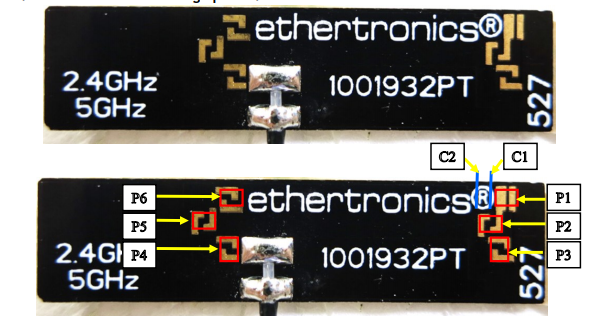- Home
- Symmetry Blog
- What are Tunable Antennas? A Complete Guide | Symmetry Blog
What are Tunable Antennas? A Complete Guide | Symmetry Blog
About Nimit Pradhan

When 4G LTE technology became widely adopted over traditional WWAN mobile network in modern mobile terminals, manufacturers faced a problem. In addition to the GSM850, GSM900, DCS1800, PCS1900 and UMTS frequency bands, LTE antennas also needed to support LTE700 and LTE2600 for global applications. This meant larger antennas, which did not go well with the trend of slimmer phones with limited space.
To solve this, traditional passive antennas were replaced with tunable antennas, providing mobile terminals with more bands and bandwidth while keeping sizes small and reducing the impact of user interference on radio frequencies.
Keep reading for the complete guide on Tunable Antennas.
What are Tunable Antennas?
A tunable antenna, also known as a reconfigurable antenna, is an antenna capable of dynamically modifying its frequency and radiation properties in a controlled and reversible manner. To provide a dynamical response, tunable (reconfigurable) antennas integrate an inner mechanism (tunable materials) that enables the intentional redistribution of the RF currents over the antenna surface and produce reversible modifications over its properties. Tunable antennas can be used for any antenna application such as WAN, WLAN, RFID, mobile TV, etc.
What tuning elements are most commonly used for tunable antennas?
There are several components that can be used to tune the resonance frequency of an antenna. The most common components include switched capacitors, tunable substrates, and microelectromechanical systems (MEMS).
Where are tuning elements placed in a tunable antenna?
Reconfiguration of a tunable antenna’s resonance frequency requires placing tuning components at different locations. These locations depend on the antenna type and the tuning objectives. For antennas based on wideband coupling elements, the tuner is typically placed at the feed to match the different operating frequencies of the antenna. Frequency reconfigurability can also be achieved by loading the antenna structure itself or by placing the tuner in between the antenna element and the ground plane. The latter is the most common use of tunable MEMS capacitors.
What are the advantages of Tunable antennas?
Tunable Antennas allow a mobile device to adjust its antenna to the optimal frequency band (open loop tuning). Another benefit of tunable antennas is the implementation of “adaptive tuning,” also known as closed loop tuning. Adaptive tuning continuously tries to adjust an antenna to its changing environment, like interference coming from a user’s hand. This helps eliminate signal dropout caused by holding the phone with one’s hand, also known as the “death grip.” Tunable antennas also improve the efficiency of data transmission. As an example, the antenna tuning of standard U.S. LTE can boost data rates by as much as 40 percent. Furthermore, a tunable antenna allows for more compact designs, which help smartphones maintain their size while providing greater efficiency.

Figure 1: Antenna Architecture with Tunable RF Device inside a smartphone.
What are the different types of antenna reconfiguration?
Reconfigurable antennas can be classified according to what parameter is dynamically adjusted. Among these parameters are frequency of operation, radiation pattern and polarization.
- Frequency reconfiguration Frequency reconfigurable antennas dynamically adjust their frequency of operation. They are particularly useful in situations where several communications systems converge, as the multiple antennas required can be replaced by a single reconfigurable antenna. Frequency reconfiguration is generally achieved by modifying antenna dimensions using RF-switches, impedance loading or tunable materials.
- Radiation pattern reconfiguration Radiation pattern reconfigurability is based on the intentional modification of the spherical distribution of radiation pattern. Beam steering is the most extended application and consists of steering the direction of radiation to maximize the antenna gain in mobile devices. Pattern reconfigurable antennas are usually designed using movable/rotatable structures or include switchable and reactively-loaded parasitic elements
- Polarization reconfiguration Polarization reconfigurable antennas are capable of switching between different polarizations. The capability of switching between horizontal, vertical and circular polarizations can be used to reduce polarization mismatch losses in portable devices. Polarization reconfigurability is accomplished by changing the balance between the different modes of a multimode structure.
- Compound reconfiguration Compound reconfiguration is the simultaneous tuning of several antenna parameters. The most common application of compound reconfiguration is the combination of frequency agility and beam-scanning to provide improved spectral efficiencies.
Recommended Suppliers for Tunable Antennas
Symmetry Electronics is a leading distributor of wireless technologies, including tunable antennas. One of our trusted suppliers for tuning antennas is Ethertronics, whose breakthrough Active Steering technology combines their patented Isolated Magnetic Dipole™ (IMD) antenna technology with their active antenna systems approach. Ethertronics provides users with the ability to generate multiple radiation patterns from a single antenna structure. A patent-pending algorithm then samples and switches between the radiation patterns to select the best one in response to the specific environment. The resulting Active Steering technology dynamically responds to changing RF conditions – fast enough to minimize multipath fading and, in turn, increase both download speeds and connectivity.
For frequency tuning, the Ethertronics 1001932PT/1001932FT has a unique feature of enabling limited range RF tuning by leaving the P1-P6, C1–C2 solder bridged or cut. For more information, contact Symmetry Electronics.


Figure 2 & 3: Ethertronics Tunable antenna
Ethertronics have sold 1.6 Billion units, with 182 patents, 1400+ platform designs, 200+ employees globally, 80% of which are engineers. Their antenna technologies include Cellular, LTE, WiFi, GPS, GNSS, Bluetooth, Zigbee, 802.15.4, ISM Bands (433Ghz, 900Ghz & 2.4Ghz), Ant, LoRa. Ethertronics provide antenna integration services and have the machinery to provide custom casing.
Benefits of Ethertronics tunable antennas:

Conclusion:
Tunable antenna solutions are increasingly being used to enhance the radio performance of mobile handheld devices. Smart tunable antennas support more bandwidth and bands, minimize antenna size, and reduce user interference. With the maturity of the RF switch and tunable capacitor, tunable antennas have become a reality on mobile terminals.
Top featured products from Symmetry Electronics:
Part No. 1001932PT Prestta WLAN BT Zigbee Tunable Embedded PCB Antenna 802.11 2.4GHz/5GHz
Part No. 1001932FT - Prestta WLAN BT Zigbee Tunable Embedded FPC Antenna 802.11 2.4GHz/5GHz
EC477 Active Steering Processor (High-Performance Wi-Fi Applications)
EC624 - Active Steering Switch (High-Performance Wi-Fi Applications)
EC482 WiFi Active Steering Processor
EC469 Cellular Active Steering Processor
EC614 Ultra-Fast Tuning SP4T
EC646 Ultra-Small, Low Ron Tuning SP4T
EC686 Ultra-Low, Ron Tuning SP4T
References:
[1] https://en.wikipedia.org/wiki/Reconfigurable_antenna
[2] Antenna Miniaturization with MEMS Tunable Capacitors: Techniques and Trade-Offs
[3] Tunable Antenna Introductions, Challenges and Opportunities
[4] Tunable Antenna for Smartphones Enabling Tunable Antennas Using QuickLogic CSSPs
